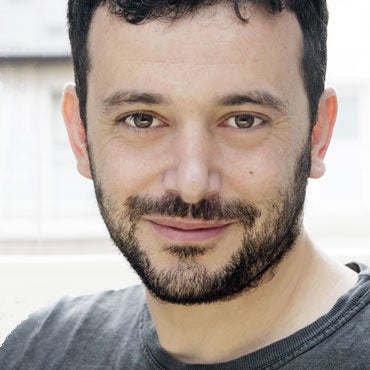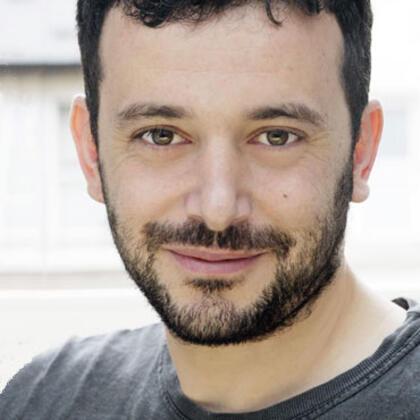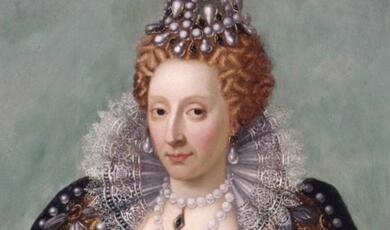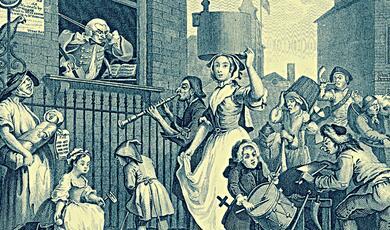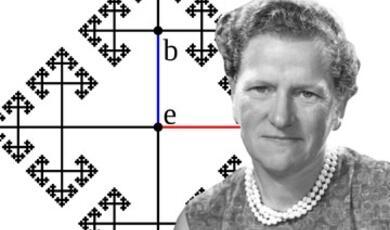Early Mathematics Day: My trip to India to Uncover the Truth about Vedic Mathematics
Share
- Details
- Transcript
- Audio
- Downloads
- Extra Reading
A lecture by Alex Bellos, freelance writer and broadcaster.
Download Transcript
6 May 2011 Crore Blimey: My trip to India to uncover the truth about vedic mathematics Alex Bellos My name is Alex Bellos, author of Alex’s Adventures in Numberland. I am not really a mathematician, though I have a degree in Maths and Philosophy from twenty years ago. I am a journalist and a former foreign correspondent, which gives me rather a different attitude towards mathematics compared with today’s other speakers. I have written about Vedic Mathematics, which certainly qualifies as ‘early’ mathematics because the Vedas are probably the world’s most ancient sacred texts that are still around today. They date from about 1,500 years ago. This afternoon I intend to tell you the story of how my interest in Vedic mathematics developed, what it is and what it revealed to me about mathematics and arithmetic more generally. I first came across Vedic mathematics simply by browsing the internet. There was, at that time, a viral YouTube video calling itself ‘Vedic mathematic’, which had half a million hits - probably the most-watched piece of mathematics on the internet. This was a couple of years ago, and as of yesterday, 600,000 people have watched it. Essentially, it is a way of doing simple multiplication by translating numbers into lines. For example, to work out something like 12 times 32, we turn each digit into a line - so 12 becomes one line, and two lines, and 32 becomes three lines and then two lines. We arrive at the answer by counting the sections, which gives us the answer – 384. The first time watching this method is always amazing, and it is very rare that a piece of mathematics becomes a viral hit. I decided that I would discover where this comes from, so I flew to the place of its origin – a place called Puri, which is in Orissa, in the Bay of Bengal, India. While I was waiting in my hotel when I got there, I picked up the paper, and the headline read: FIVE CRORE MORE INDIANS THAN GOVT THOUGHT. It was the first time I had ever been to India, so perhaps this is not so exciting to those who have been before, but I was confused by this word ‘crore.’ What on earth is a crore? I was then told that, in India, you never use the word ‘a million’ or ‘a billion’. When counting the powers of ten, they move through 10, 100, 1000, 10,000, lakh (100,000), 10 lakh (a million), and then crore, which is 10 million, and then 10 crore, and so on. I thought about the word ‘million’, and I asked, ‘Well, what about millionaire – do you have the word ‘millionaire’?’ and they said, ‘No’. I said, ‘Well, what about the film Slumdog Millionaire? That is about India!’ To which they replied, ‘Correct, though it is called Slumdog Crorepati in India!’ In fact, when you watch the film, you notice that the prize is not a million rupees at the end, it is 10 million rupees, because the guy speaking in Hindi asks, ‘Now, do you want to go for the crore?’ Already, on my first day in India, I was encountering differences in simple ways of dealing with numbers. When writing the powers of ten, the comma comes after every second number, so they count off in hundreds rather than in thousands, like we do. I carried out some research into the reasons behind this, and found that lakh and crore come from the Hindi words lakh and karod, which come from the Sanskrit, laksa and koti. A thousand, two thousand years ago, they had a word for 100,000 and 10 million. I know we are not supposed to make generalisations about the Greeks, but I do believe that the Greeks did not have a number word larger than a myriad, which is 10,000. So, when the Greeks did not get higher than a myriad, the Indians were way up into the crores. There is a wonderful section from the Lalitavistara Sutra, from the 4th Century, where the Buddha is asked to show his prowess at mathematics, and he is told to ‘go up’ from lakh and crore, which would have been laksa and koti. He said that 100 koti (crore) are in an ayuta, 100 are in a niyuta, a 100 niyuta make a kangkara, and so on, until he gets to 10421! That is a big number! In terms of all the atoms in the universe, there are probably only about 1080, so this is beyond everything really, it is not really about numbers or calculating, there is something mystical is going on there. Then, interestingly, he is asked the opposite – if he is good at counting big numbers, how good is he at counting small numbers? The Buddha is asked to divide up a yoyana (about ten kilometres), and he says, ‘Four krosa are 1,000 arcs, each of which are the length of four cubits, each of a length of two spans, each of which is the length of twelve phalanges of fingers,’ so we are dealing with a few centimetres now, ‘each of which is the length of seven grains of barley, each of which is the length of seven mustard seeds, which was the length of seven poppy seeds, which is the length of seven particles of dust stirred up by a cow, each of which is the length of seven specks of dust disturbed by a ram, each of which is the length of seven specks of dust stirred up by a hare, each of which is the length of seven specks of dust carried away by the wind, each of which is the length of seven tiny specks of dust, each of which is the length of seven minute specks of dust, each of which is the length of seven particles of the first atoms.’ This is obviously poetic as much as anything, but a physicist or chemist calculated that, if the phalanges of the fingers are four centimetres, then the Buddha went as far as 4cm x 7-10, which works out as 0.00000000001416, which is more or less the size of a carbon atom. Spooky! This is another reason why lots of people get very mystical and slightly lose a sense of reason when they are talking about Vedic mathematics and Vedic physics. Within these areas, however, there is a lot of serious stuff going on. Because I am a journalist and not a mathematician, I did not have the brain power to work out some of the equations. I read a wonderful, enormous book called The Universal History of Numbers, which was something of a labour of love by a French schoolteacher who was asked by one of his kids, ‘Where do numbers come from?’ He basically spent the next 30 years going all round the world trying to work it out. He discovers many seriously amazing things, and one of the things he writes about – and he is the only person that seems to write about these things that I could find – is the way in which, before the symbols for digits in India were secure, the Indians had a very interesting way of remembering large numbers. Obviously, they knew about large numbers because they have got words for them, but within certain advanced areas like Indian astronomy, they needed some ways of remembering these really large numbers. This is what they would do. I am not a Sanskrit scholar, but Sanskrit is a sacred language andhas to be written according to certain rules. This produces something that looks like a poem: The apsides of the moon in a yuga Fire. Vacuum. Horsemen. Vasu. Serpent. Ocean, and of its waning node Vasu. Fire. Primordial Couple. Horsemen. Fire. Twins. Which equates to: [The number of revolutions] of the apsides of the moon in a cosmic cycle [yuga] is Three. Zero. Two. Eight. Eight. Four. and of its waning node Eight. Three. Two. Two. Three. Two. The numbers of revolutions of the aspects of the Moon in the cosmic cycle, the yuga, is just 302884, and its waning node is 832232. Actually, the number would be read the other way round – ‘Three’ means ‘three units’, ‘zero’ means ‘no 10s’, ‘two’ 100s, ‘eight’ 1,000s, ‘eight’ 10,000s, and ‘four’ 100,000s. To make it easier to remember these important numbers, you translate each one into a word, because you are much more likely to remember something that sounds poetic. So, if you had a zero in these Ancient poems, you could use either ‘dot hole’ or ‘the serpent of eternity’, amongst other things. For one, you could use earth, moon, pole star, curdled milk – there is a 100 page dictionary of these different words that they used for numbers in The Universal History of Numbers. As you can see, you can be quite clever when finding different ways to adopt numbers and astronomy in that culture. I went to Puri because of Shankara, who was the very first Shankaracharya, a sort of Hindu seer. The most reliable sources of information claim that he was around in the 8th century AD. Hinduism is older than Buddhism, but then Buddhism came along and then India was Buddhist for a while. Following this, Hindu seers realised that they needed to adapt some of these Buddhist ideas, which led to India becoming Hindu again. In the great wave of Indian ‘re-Hinduisation’, Shankara was quite important. He set up four big temples, one at each of the four corners of India, which were called, auspiciously, ‘Mathas’. That is nothing to do with ‘maths’ – it is just the Sanskrit or Hindu word for ‘temple’. I was visiting the westernmost temple, in Puri. At each of these temples, there is a Shankaracharya, which is comparable to an Archbishop. It is very difficult to compare Hindu leaders (of a system that is totally non-hierarchical) with the Judao-Christian idea of leaders, which is very hierarchical. The Shankaracharyas are possibly some of the most revered spiritual figures in Hinduism. In 1925, the Shankaracharya at Puri was Jagadguru, which is a title meaning ‘big guru’. His full name was Shankaracharya Swami Sri Bharati Krishna Tirthaji, and really known as Tirthaji. He was a fascinating character, both in terms of his interests and the time that he lived in. He was born in 1876. He was a child prodigy. When he was twenty, he graduated in Sanskrit, Philosophy, English, Maths, History and Science, and people saw that that he was going to become a great thinker. He was also very political and, at a time when Indians were fighting the English, he was imprisoned for a while for being so polemical. During this time he came up with what is called Vedic mathematics. In 1925, he was made Shankaracharya at Puri, and he was Shankaracharya up until 1960, when he died. During this time, he would go round this part of India and speak to his flock, as it were, about faith but also about Vedic mathematics. He said that he had gone into the forest for several years, taking only the Vedas, which he studied. He discovered that, in the Vedas, there were sixteen hidden sutras, or formulae, which made mathematics much easier. That which would normally take you ten years to learn, could now be learnt over three months using these sutras. The first eight are as follows: 1. By one more than the previous one 2. All from 9 and the last from 10 3. Vertically and crosswise 4. Transpose and apply 5. Transpose and adjust (the coefficient) 6. If the Samuccaya is the same (on both sides of the equation, then) that Samuccaya is (equal to) zero 7. By the Paravartya rule 8. If one is in ratio, the other one is zero. When you first looks at them, they seem completely bonkers! What do they mean?! His idea was to hold lectures and explain that these sixteen sutras were all in the Vedas and could help people do maths better. At the end of each lecture, he would give his audience a few helpful tricks. He attracted quite a lot of fame in India, and in 1958 he was the first Shankaracharya ever to leave India, which was supposedly forbidden – no one has done it since. He went to the East Coast of America, which was promoted as big news in The New York Times and The LA Times. This was one of the world’s most spiritual men, and accordingly he went on a number of chat shows and gave a number of lectures on world peace. This was the time of the Cold War, and he was very much into ‘Make love, not war’. By the way, this was before the 1960s image of the hippy Indian guru had established itself. This was 1958, and at that time, America had not seen anything like it. He also did a famous talk at Cal-Tech, to an audience comprising the smartest, brightest mathematicians in America, on the West Coast (apologies to Stanford!). The lecture notes are still around, showing exactly the things that he taught them. Firstly, he told the story of his journey into the forest and stressed that his audience members could not have discovered tehse formulae themselves – only he could have done that, as a spiritual man, well versed in the Vedas. He described the formulae like puns, like words that most people might read one way but that he could read another way. I am sure he said that with a smile on his face. One of the things that he showed was an interesting way to multiply two numbers together. I shall multiply 7 x 8: You start by taking the difference of each number from 10. For 7, this is 3; for 8, this is 2. You then multiply these together, which gives you 6. Then, you just either add -3 to 8 or -2 to 7, and you get 5. 56 is the answer. As long as you multiply two numbers above 5, it always works. I shall now multiply 97 x 96: The differences from 100 are 3 and 4 respectively, so we multiply these together to get 12. We then either add -3 to 96, or -4 to 97, to get 93. The answer is 9312. Supposedly, all of these students at Cal-Tech were amazed and Vedic mathematics became immensely popular. However it still remained largely unknown in India, except to those who had attended Tirthaji’s lectures, because he never actually published anything. He died in 1960, supposedly having written sixteen books on the subject, of which fifteen have never been found. The first one, the introduction, was published as Vedic Mathematics in 1965. Upon publication, there was little interest. This remained the case until the beginning of the 1970s, when India was ‘in vogue’, and a group of British visitors found the book at the back of the shelf in an ashram. They brought it back to the UK and began to promote it. There are lots of books about it, mostly from Britain and with a few pioneers in the field, and now India is ‘re-learning’ the concept from us. It is certainly a growing field in India nowadays. So this is basically what Vedic mathematics is. It gives you many fun tricks to do with arithmetic. I shall return to the problem I showed you at the start of the lecture: Essentially what we are doing here is 2 x 2; here it is 2 x 1; here it is 3 x 2; here it is 3 x 1. The reason why long multiplication is called long multiplication is because it takes longer than what we could do, which is short multiplication – the method shown above – and which is also known as cross-multiplication. While at Puri, I wanted to meet the current Shankaracharya. I wanted to ask if these formulae were really just derived from the Vedas. He was obviously a Brahmin and spoke perfect English, but in the temple you are not allowed to speak English, so I had to communicate via his interpreter - which is a brilliant way of not answering my questions! I would ask a question such as, ‘Can you give me a page number where I can find ‘vertically and cross-wise’ in the Vedas?’ This question would go through the disciple, who would spend some time translating what took me ten words to say into about twenty words in Hindi. He would then pose this to the Shankaracharya, who would think about it as if he had only just understood it (though he had obviously understood it before). He would spend about five minutes replying to the interpreter in Hindi, who would then spend about ten minutes replying to me. It was like a game of Chinese whispers – absolutely nothing at all to do with the questions I asked! I began to realise that if you ask a rational, scientific question to someone so concerned with religion, spirituality and metaphysics, you are never really going to get anywhere. I visited him four times, because each time the interview took two hours and I only managed to ask three questions. As mentioned earlier, the place value system of numbers first occurred in China and India. The numbers that we use today are akin to Hindu-Arabic numbers, from India. One of the great mathematic advances from India was the invention of zero. (Usually, when I give talks, I make the old joke: ‘What did India give the world? Nothing!’) By just looking at this man, I realised that India is the obvious place for zero to come from. Hinduism is nothing, unless it is something. This man is the embodiment of having nothing. He has no possessions. He has one thing that he wears all the time. He apparently eats the same, bland curry every day. During my time with him, people would come in, prostrate themselves before him and offer gifts. As soon as he got a gift, he would simply pick it up and give it to someone else. To someone who was not aware of the culture, it looked like he was a bit annoyed with these incoming gifts coming, as if he had received too many presents and felt like redistributing them. I ended up with a whole bowl of fruit round me! I returned from India with the realisation that the number system emerged there because of the metaphysical, spiritual way that nothingness meant something. Furthermore, why is the circle used as the digit for the number zero? When I was young, it seemed to me as if the hole of a ‘0’ was a visual symbol for nothing, but that completely misses the point. Rather, the circle represents the eternal cycle of the heavens – both the infinite and nothing at the same time. Each time we write a zero on a piece of paper, we maintain an ancient, Vedic way of looking at the world. As well as giving the world zero, India has recently given the world the first zero currency notes – zero rupee! To me, this is very poetic. It was developed by an NGO as an anti-corruption tactic, so that when you bribe someone – which you are continually forced to do - you give them a zero currency note as a way of making the point ‘I am giving you nothing, but it is something.’ Now, do not suppose that everyone in India thinks that Vedic mathematics is great. Actually, most serious mathematicians think that Vedic maths is mad. I went to see one of their top mathematicians, S. G. Dani, who is the top professor at the Tata Institute in Bombay. He has written quite a lot of savage attacks on Vedic mathematics, saying that it makes Indians seem stupid and silly, and reinforces prejudices of India being a third-world country. Would we believe it if someone said they read the Bible and discovered the quadratic formula in it? Dani argues that it is not good for the Indian self-image. However, as we got chatting, I found that he actually had a lot of sympathy for Tirthaji and what Tirthaji was trying to do. By calling it Vedic mathematics, the man was making a politically charged , anti-colonial statement at the turn of the century, when the Indians were turning against the British. The theory emerged out of a feeling that the English had even taken numbers from the Indians, which really belonged to the Indians, and Indians should feel proud of those numbers. So, though Dani does not approve of Vedic mathematics on an intellectual level, he can empathise with Tirthaji on an emotional level and see what he was trying to achieve. It is always quite easy to parody other cultures for doing something ‘a bit crazy’, and I would not want to be seen to be someone who is dismissing Vedic mathematics, because the actual arithmetical tricks that are there are all perfectly valid. There is nothing silly about them at all. If, in order to try and educate a nation, you point out parts of a heritage and embellish them, I think that that is a perfectly acceptable means to do so and to popularise mathematics. When I got home, I wanted to look into some of these tricks. I bought the Trachtenberg method of arithmetic, and found that there are huge overlaps. Then, I read the Liber Aberci, Fibonacci’s 13th century book that introduced Hindu-Arabic numerals to Europe, and found that it is almost a recreational math book. It presents fun ways of counting and exciting number puzzles. In terms of multiplication, it shows methods that are vertical and crosswise! If the very first book has got the same tricks that are in Vedic mathematics, who is not to say that Indians were the first people to do that? I got in touch with David Sigmaster, who knows lots about recreational mathematics, and he told me that all this stuff was well-known by Victorians, and that Tirthaji was probably a schoolteacher, and he would have picked up all these things as tricks. But actually, if you look at books from the 13th, 14th and 15th centuries, they all use very similar methods. I was also reading Florian Cajori’s History of Mathematical Notations, a book that should be required reading for all those interested in the history of mathematics. It is an amazing book. It considers things like the origin of the ‘x’ in multiplication. The first person to use it was William Oughtred in 1631, but before he used it in the way we use it now, he said that there were eleven different ways that the ‘x’ had already appeared in multiplication literature. To me, the method that I have shown you today seems a likely source of this ‘x’ - multiplying two things by splitting them apart. Though my initial reaction to Vedic maths was one of distrust, I came to realise that all maths is essentially Vedic. We can trace our notions of maths to the Vedic, spiritual culture of zero, and the invention of number positions. Even though the Greece had numbers, arithmetic only really became part of mathematics when the Hindu-Arabic numerals superseded Roman numerals in the Renaissance. Therefore, we are all Vedic mathematicians! Thank you very much. C, Alex Bellos, 2011
Part of:
This event was on Fri, 06 May 2011
Support Gresham
Gresham College has offered an outstanding education to the public free of charge for over 400 years. Today, Gresham plays an important role in fostering a love of learning and a greater understanding of ourselves and the world around us. Your donation will help to widen our reach and to broaden our audience, allowing more people to benefit from a high-quality education from some of the brightest minds.


 Login
Login
